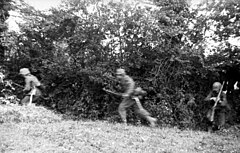LXXIV Korpus Armijny (III Rzesza)
| Historia | |
| Państwo | |
|---|---|
| Działania zbrojne | |
| II wojna światowa | |
| Organizacja | |
| Rodzaj sił zbrojnych | lądowe |
| Formacja | |
| Podległość | |
LXXIV Korpus Armijny, niem. LXXIV. Armeekorps – jeden z niemieckich korpusów armijnych.
Utworzony w lipcu 1943 roku w XI Okręgu Wojskowym dla Naczelnego Dowództwa Zachód. Do maja 1944 roku stacjonował w Bretanii (Grupa Armii D). Po inwazji alianckiej na Normandię wziął udział w walkach obronnych, wchodząc w skład Grupy Armii B (kolejno: 5 Armia Pancerna, 7 Armia, 15 Armia, znowu 5 Armia Pancerna i ponownie 15 Armia). Walczył m.in. na terenie północnych gór Eifel i w Zagłębiu Ruhry. Zniszczony na przełomie kwietnia i maja 1945 roku.
Dowódcy korpusu
- generał piechoty Erich Straube (do grudnia 1944)
- generał piechoty Carl Püchler
Skład
Jednostki korpuśne
- 474 Dowództwo Artylerii
- 474 batalion łączności
- LXXIV Oddział Forteczny
we wrześniu 1944
- grupa bojowa 347 Dywizji Piechoty
- 3 Dywizja Strzelców Spadochronowych
- 526 Dywizja
w marcu 1945
- 3 Dywizja Strzelców Spadochronowych
- 85 Dywizja Piechoty
- 272 Dywizja Grenadierów Ludowych
Bibliografia
Media użyte na tej stronie
(c) Bundesarchiv, Bild 101I-583-2130-27 / Reich / CC-BY-SA 3.0
The Imperial Eagle or Emblem of the German Empire (German Reich, used 1935–1945), which features an eagle looking over its right shoulder, that is, looking to the left from the viewer's point of view. It is similar to the Parteiadler or Emblem of the Nationalsozialistische Deutsche Arbeiterpartei (NSDAP; known in English as the National Socialist German Workers' Party, or simply the Nazi Party), but the eagle of the latter is looking over its left shoulder, that is, looking to the right from the viewer's point of view.



